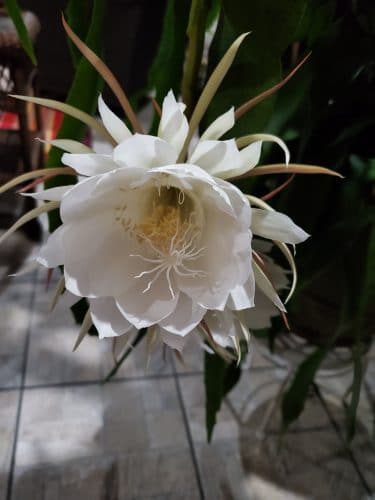The Queen of the Night
October, 22 2020
Growing up in southern Virginia, I remember hearing my grandmother and mother talk about a magical plant – the night blooming cereus. The plant took on a mysterious aura for me, especially since I never saw one either at a friend’s home or for sale in a garden center. But recently a friend acquired a cutting from a fellow Garden Club member, and when she was giving away plants before moving back North, she asked if I wanted any of her plants. I excitedly said “I’d love a piece of the night blooming cereus!”
I inherited the entire plant, which I promptly put into a very large pot to keep on my lanai. Then I added a trellis to the pot because the plant seemed to be growing overnight and it appeared intent on climbing. I knew the plants usually flower after several years in a pot, so I somewhat ignored my new treasure, other than watering it regularly.
Imagine my surprise when 5 buds appeared! The buds were tiny at first, then seemed to grow exponentially. Three buds didn’t progress very well and dropped off, so I was left with 2 buds to observe. Each day I was amazed at how much the buds grew overnight; pale pink “tendrils” embraced the growing white inner flower. After about 3 weeks, the buds were 6 inches long and one morning I noted a slight “opening” of the buds. I wasn’t sure how long it would take the buds to fully open, but I suspected that it would be within a day or two. During the day I marked the progress of the buds and decided that they would open that night. At dusk, the flowers were beginning to swell and open, and by 9 p.m. they had opened. The scent was intoxicating! By midnight the flowers were fully opened, and when I walked through the sliding door to the lanai, the sweet scent from those two blooms was overwhelming.
The next morning, the flowers were closed and over the following days they slowly wilted and fell off the plant. (I have since learned that you can pick the flower at night and store it in the refrigerator so you can admire it the next morning!) Since I had seen the beautiful “show,” which I believed was an annual event, I decided that I would place the rapidly growing plant in the garden so it could expand at will. Then I noticed more emerging buds! I now have 3 buds that should probably flower in the next 10 days and I’m looking forward to another spectacular evening performance.
The night blooming cereus is a type of orchid cactus native to rain forests, where it grows high in the trees. As it grows in a riot of tangled “leaves,” the plant can reach 10 feet, which is why a trellis is often recommended. As a member of the cactus family, the cereus plant does not have true leaves. The plant produces pencil-shaped stems that allow the plant to climb, and flattened stems that resemble and function as leaves. “Leaves” that have been on the plant for two active seasons produce the flower buds, which form on the indentations of the notched “leaves.” In most areas the cereus is a houseplant that enjoys summers outside, but here in Southwest Florida it thrives year-round in our subtropical climate. The plant requires bright light, preferably morning sun as the stronger afternoon rays can burn the “leaves.” The cereus should be planted in well-draining soil and allowed to dry between regular watering. A water-soluble fertilizer is recommended during the spring, although I have never applied fertilizer and my plant is growing at warp speed. The cereus is a classic “pass-along plant” and can be propagated by easy to root cuttings.
The night blooming cereus has proven to be a highlight of my gardening adventures here in Southwest Florida. After hearing of this mystical plant for my entire life, I am elated to have finally acquired a cereus plant and to be rewarded with blooms so quickly. I hope that you will ask for a cutting if you know of a fellow gardener with a night blooming cereus; you will undoubtedly be as fascinated as I have been watching the progression of this magical plant!
—
Cathy Dunn is a member of the Garden Club of Cape Coral and a Lee County Master Gardener Volunteer.
